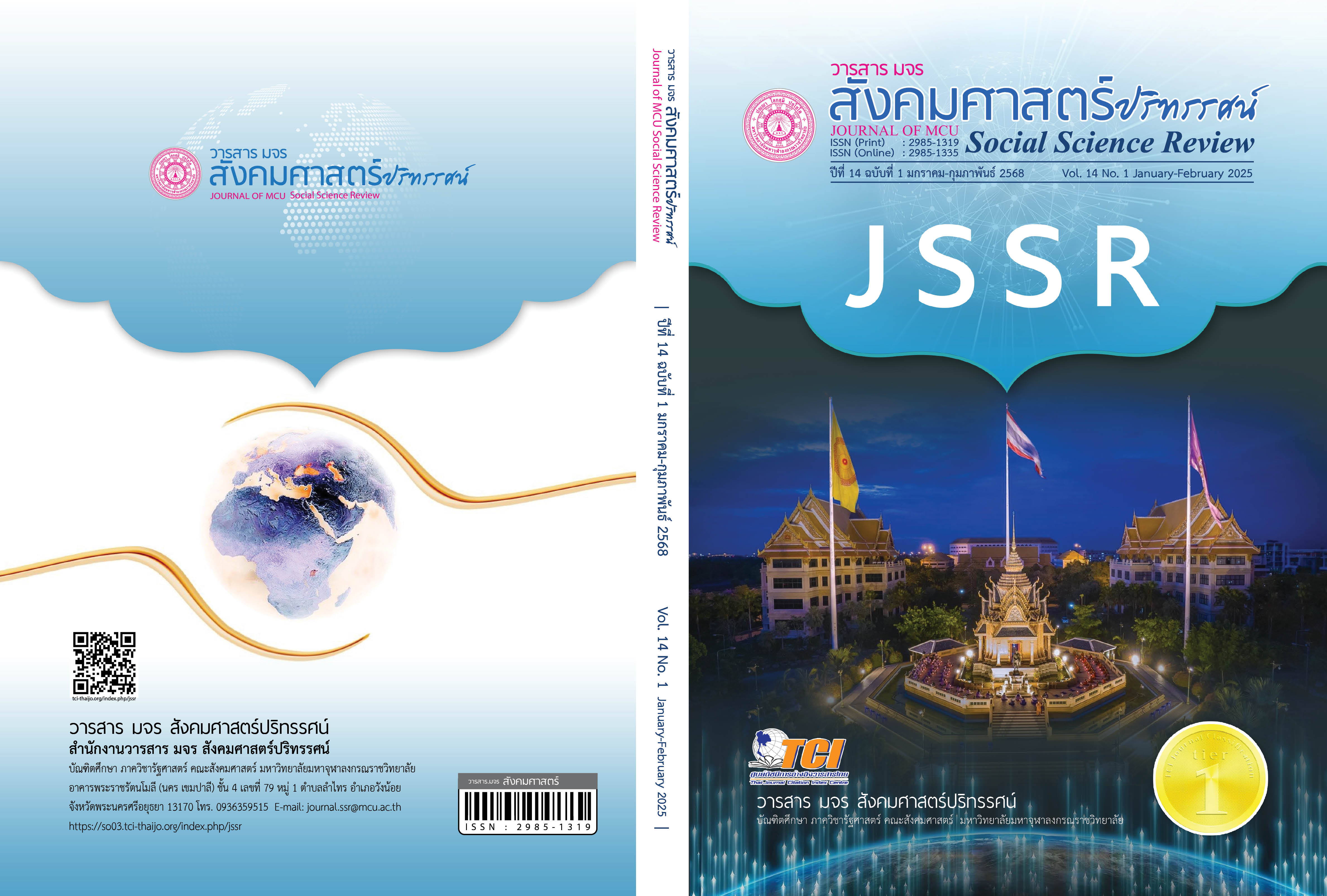การเห็นคุณค่าและการมีส่วนร่วมของประชาชนในการดูแลต้นไม้มรดก อำเภอนครไทย จังหวัดพิษณุโลก
คำสำคัญ:
ต้นไม้มรดก, ยางนา, จำปาขาว, การมีส่วนร่วม, การเห็นคุณค่าบทคัดย่อ
บทความวิจัยนี้มีวัตถุประสงค์ 1. ศึกษาระดับการมีส่วนร่วมดูแลต้นไม้มรดก และการเห็นคุณค่าต้นไม้มรดกของประชาชน 2. เปรียบเทียบการมีส่วนร่วมดูแลต้นไม้มรดก และการเห็นคุณค่าต้นไม้มรดกของประชาชน และ 3. ให้ข้อเสนอแนะในการอนุรักษ์ต้นไม้มรดกของประชาชนในอำเภอนครไทย จังหวัดพิษณุโลก โดยใช้ระเบียบวิธีวิจัยเชิงปริมาณ เก็บข้อมูลด้วยแบบสอบถามจากกลุ่มตัวอย่าง 310 คน วิเคราะห์ข้อมูลด้วยความถี่ ร้อยละ ค่าเฉลี่ย ส่วนเบี่ยงเบนมาตรฐาน สำหรับ การทดสอบสมมุติฐานใช้การวิเคราะห์ความแปรปรวนแบบทางเดียว การนำเสนอผลการศึกษาใช้การพรรณนาประกอบตารางสถิติ
ผลการวิจัยพบว่า ระดับการมีส่วนร่วมดูแลต้นไม้มรดกในภาพรวมของกลุ่มตัวอย่างอยู่ในระดับมาก โดยข้อที่มีค่าเฉลี่ยสูงที่สุด คือ การเข้าร่วมงานบวชต้นไม้ หรือการปลูกต้นไม้ สำหรับการศึกษาระดับการเห็นคุณค่าต้นไม้มรดก พบว่า ในภาพรวมมีการเห็นคุณค่าอยู่ในระดับมากที่สุด โดยข้อที่มีค่าเฉลี่ยสูงที่สุด คือ ต้นไม้มรดกก่อให้เกิดการสืบทอดเอกลักษณ์ทางวัฒนธรรม สำหรับผลการทดสอบสมมุติฐาน พบว่า คะแนนเฉลี่ยการมีส่วนร่วมดูแลต้นไม้มรดก
มีความแตกต่างกันตามระยะเวลาที่อาศัยในชุมชน และการประกอบอาชีพ สำหรับตัวแปรการเห็นคุณค่า ต้นไม้มรดก พบว่า การเห็นคุณค่าต้นไม้มรดกมีความแตกต่างกันตามภูมิลำเนา ผลการจัดลำดับข้อเสนอแนะแนวทางการมีส่วนร่วมของประชาชนในการดูแลต้นไม้มรดก พบว่า จากทั้งหมด 11 ข้อ ข้อที่มีผลรวมร้อยละสูงที่สุดอันดับที่ 1 คือ ให้ความรู้แก่เด็กและเยาวชนในท้องถิ่น อันดับที่ 2 ได้แก่ จัดทำป้ายบอกตำแหน่งที่ตั้ง และอันดับที่ 3 ได้แก่ ส่งเสริมกิจกรรมการท่องเที่ยวเชิงวัฒนธรรมในพื้นที่
เอกสารอ้างอิง
กวินธร เสถียร และคณะ. (2566). ยางนาและจำปาขาว: สถานภาพและแนวทางอนุรักษ์รุกขมรดก กรณีศึกษา อำเภอนครไทย จังหวัดพิษณุโลก. วารสารสังคมศาสตร์ มหาวิทยาลัยนเรศวร, 19(2), 175-208.
ฐิติมา ญาณะวงษา และมานูนณย์ สุคีตา. (2560). การศึกษาประวัติศาสตร์ท้องถิ่นอย่างมีส่วนร่วมของชุมชนสารภี อำเภอสารภี จังหวัดเชียงใหม่: ต้นยางนาและถนนสายเชียงใหม่-ลำพูน. วารสารวิชาการมหาวิทยาลัยฟาร์อีสเทอร์น, 11(1), 296-308.
เทศบาลตำบลนครไทย. (2562). แผนพัฒนาท้องถิ่น (พ.ศ.2561-2565). พิษณุโลก: เทศบาลตำบลนครไทย.
บรรจง สมบูรณ์ชัย และคณะ. (2561). การฟื้นฟูต้นยางนา ในเขตเทศบาลตำบลยางเนิ้งเพื่อการอนุรักษ์สภาพแวดล้อมอย่างยั่งยืน. เชียงใหม่: มหาวิทยาลัยแม่โจ้.
บุญวงศ์ ไทยอุตส่าห์ และคณะ. (2550). ไม้ยางนา จากป่าสู่วัง. กรุงเทพฯ: สำนักพระราชวัง.
พัชรา คงสุผล. (2561). ถอดบทเรียนโรงเรียนต้นไม้. วารสารสาระศาสตร์, 1(4), 571-584.
มูลนิธิสืบนาคะเสถียร. (2565). พิธีบวชป่า การผสานความเชื่อทางศาสนากับการอนุรักษ์ ธรรมชาติ. สืบค้น 13 พฤศจิกายน 2567, จาก https://shorturl.asia/X7I5y
สุชาดา จักรพิสุทธิ์. (2547). ปฏิรูปการศึกษาในสังคมไทยชุมชนกับการมีส่วนร่วมจัดการศึกษา นักวิชาการมหาวิทยาลัยเที่ยงคืน. สืบค้น 10 พฤศจิกายน 2567, จาก http://www:midnightuniv.org /midnight2545/document9562.html
องค์การบริหารส่วนตำบลเนินเพิ่ม. (2562). แผนพัฒนาท้องถิ่น (พ.ศ.2561-2565). พิษณุโลก: องค์การบริหารส่วนตำบลเนินเพิ่ม.
องค์การยูเนสโก. (2565). ข้อเสนอทางนโยบาย ชุมชนชาติพันธุ์และการจัดการมรดกอย่างยั่งยืนในประเทศไทย. สืบค้น 10 พฤศจิกายน 2567, จาก https://shorturl.asia/Payk4
Koufman, H. F. (1949). Participation Organized Activities in Selected Kentucky Localities. Kentucky: Lexington.
Krejcie, R. V. & Morgan, D. W. (1970). Determining Sample Size for Research Activities. Educational and Psychological Measurement, 30(3), 607-610.
ดาวน์โหลด
เผยแพร่แล้ว
รูปแบบการอ้างอิง
ฉบับ
ประเภทบทความ
สัญญาอนุญาต
ลิขสิทธิ์ (c) 2024 วารสาร มจร สังคมศาสตร์ปริทรรศน์

อนุญาตภายใต้เงื่อนไข Creative Commons Attribution-NonCommercial-NoDerivatives 4.0 International License.
เพื่อให้เป็นไปตามกฎหมายลิขสิทธิ์ ผู้นิพนธ์ทุกท่านต้องลงลายมือชื่อในแบบฟอร์มใบมอบลิขสิทธิ์บทความให้แก่วารสารฯ พร้อมกับบทความต้นฉบับที่ได้แก้ไขครั้งสุดท้าย นอกจากนี้ ผู้นิพนธ์ทุกท่านต้องยืนยันว่าบทความต้นฉบับที่ส่งมาตีพิมพ์นั้น ได้ส่งมาตีพิมพ์เฉพาะในวารสาร มจร สังคมศาสตร์ปริทรรศน์ เพียงแห่งเดียวเท่านั้น หากมีการใช้ภาพหรือตารางหรือเนื้อหาอื่นๆ ของผู้นิพนธ์อื่นที่ปรากฏในสิ่งตีพิมพ์อื่นมาแล้ว ผู้นิพนธ์ต้องขออนุญาตเจ้าของลิขสิทธิ์ก่อน พร้อมทั้งแสดงหนังสือที่ได้รับการยินยอมต่อบรรณาธิการ ก่อนที่บทความจะได้รับการตีพิมพ์ หากไม่เป็นไปตามข้อกำหนดเบื้องต้น ทางวารสารจะถอดบทความของท่านออกโดยไม่มีข้อยกเว้นใดๆ ทั้งสิ้น





